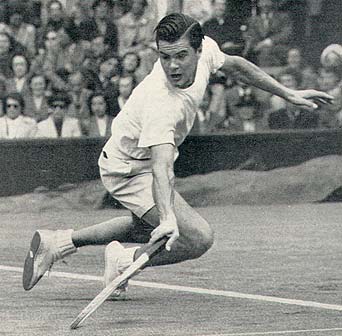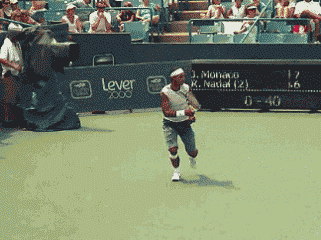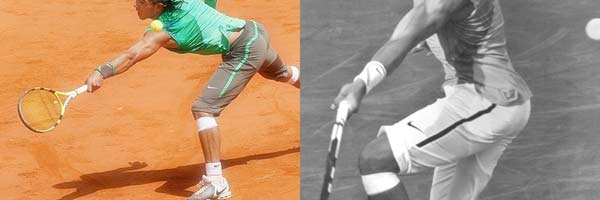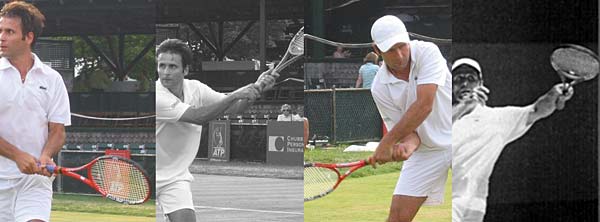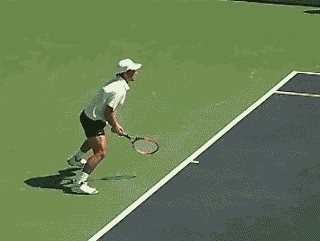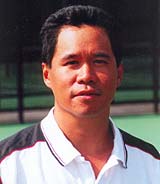|
TennisOne Lessons Emergencies and Reversing the Grip Doug Eng EdD, PhD
A while back I wrote an article entitled Grips and Positioning For Successful Doubles. In the article I suggested in order to volley better, you may want to modify your grip to produce stronger volleys for balls through the middle of the court. In this article, let’s discuss emergencies situations and what I call the art of reversing the grip. It’s an advanced skill that many touring pros use and worthwhile for the aspiring 4.0 or higher player to try. I even have 3.0 and 3.5 players playing with the grip to improve their understanding of what a grip really should allow you to do. The primary purpose of any grip is to control the racquet face so the ball can go over the net. The second purpose is to hit solidly, which is really more affected by body position rather than grip. A third purpose is spin production. Your grip(s) and the use of your wrist and forearm should allow you to adapt to irregular bounces, different heights and spins. Whenever you play against a better player who hits harder, you will find yourself in emergency situations where your contact point or comfort level is not optimal. You may be forced to stretch for the ball. Or the ball might awkwardly bounce at your feet. You may find yourself late at contact trying to improvise. The ability to scrap and improvise to play difficult balls will help you become a better player.
Some pros feel that almost nothing is new in tennis. I agree. It appears that new ways of hitting have cropped up over the years but every grip has been already tried over the past century. It’s just that in some eras, equipment technology and athleticism can alter the way top athletes play. Today with exceptional athletes, light racquets, and strings with bite (e.g, Luxilon), the professional game is dominated by topspin, angular momentum, and the family of western grips. And it is easier to play improvisational or emergency strokes today due to highly maneuverable racquets. Club players tend to be slower in court coverage but more diverse in stroke mechanics so even if they may not play professional-like groundstrokes, they will encounter emergency situations frequently. In this article, we’ll take a look at players of yesteryear and today. The Emergency Forehand
In Photo 1, we see tennis legend Pancho Segura stretched out for a forehand. His contact point is well behind him so he won’t generate an offensive shot but rather he is primarily trying to stay in the rally. If you look at Pancho’s grip, you’ll note it is not a forehand grip but an eastern backhand grip. He makes contact with the ball near his back foot. Let’s fast-forward to today and take a peek at Roger Federer. We are fortunate that TennisOne.com has the most comprehensive video collection on-line. Video 1 shows Federer on the run. This clip is very subtle so watch carefully and we’ll play it in slow motion during the contact point and follow through. Federer starts off with his regular hybrid grip (somewhere between an eastern forehand and a semi-western). Just before contact, you can see his grip is still in that position but quickly look at contact and most noticeably on the follow through. Did you see a bit of magic? Roger switched his grip just before contact and you can actually see on the follow through that he used an eastern backhand grip. Roger improvised on this shot midway through his swing as the ball was a bit wide and he was late. How was he able to play this improvised shot? Here are three things to note:
There are two situations where the backhand grip can be used on the forehand: At the baseline when you are stretched and the ball is behind you and at the net if you are stretched to cover the deuce alley on the forehand volley (for a right-handed player) especially in doubles. There is another situation about which you may have heard commentators talk about, the “squash shot.” With the lighter racquets and modern pace of the game, the squash shot is being used more and more often in tennis. When stretched wide on the forehand or the forehand return of serve, it can be an effective shot as Carlos Moya shows below.
The key is to prepare the racquet head high (upright) and with an open string bed in the backswing with a continental or an eastern backhand grip. When swinging forward, let the elbow lead and wrist flick or whip the racquet to carve the strings around the outside of the ball. Interesting enough, there was a great article in the London Times on Roger Federer and the fact that he played squash with his father each Sunday until he was 13 years old. Roger attributed squash to helping him with his ability to improvise. Federer’s and Moya’s forehand in the video clips show their ability to improvise and play defense with the emergency forehand. Federer showed a superb example of reversing the grip, that is, he played a forehand groundstroke with a backhand grip making his change in the middle of his swing. The Emergency Backhand
In Photo 3, we see the late great Sven Davidson (who passed away in May) in his younger years improvising his backhand on a wide low ball. Sven has remarkable dynamic balance and his head and eyes remained focused on the contact point. Sven’s grip is even more extreme than Bob Bryan’s and very much in a variation of the eastern forehand grip.
Now at TennisOne.com we have high definition videos of many touring pros. There is a great HD video of Rafael Nadal showing how he adjusts to a ball behind him. Rafa (see Video 4) switches to an Australian (almost eastern) forehand grip to hit the backhand. Below are a couple recent photos (Photo 4) showing Nadal’s grip. Although teaching pros often teach you to use the dominant (or lower) hand as a continental or eastern backhand grip, an eastern forehand is feasible in these emergencies if you have a strong wrist. Often we say using the eastern forehand weakens the volleys and other shots but here in Nadal’s case it is used as an emergency shot. On the right photo, if it wasn’t for the ball, you can see that it looks more like Nadal is hitting a forehand. Rafael Nadal, Bob Bryan and Sven Davidson show great improvisation in playing defense and reversing the grip. That is, they have the ability to play variations of forehand grips in order to defend on the backhand.
The Magician Fabrice Santoro is one of the most fun players to watch since he confounds us with his myriad of shotmaking. Santoro will play with both hands on the forehand and backhand letting go one hand at times on either stroke. In the two left photos (Photo 5) we see how unusual his forehand grip is as his non-dominant hand stays higher on the racquet before contact and the dominant hand lets go on the follow through.
We can also see that Santoro uses a bit of wrist extension and a bit of grip change on his emergency one-handed backhand in Video 5.
For many of you two-handed backhanders, the one-handed backhand is an emergency shot which you should learn to use. Like Santoro, Moya and Nadal who are two-handers, when you let go, you should experience playing:
I differentiate between the block backhand and the chip backhand by the amount of spin and deliberateness of the stroke. A block can be flat or have less underspin than a chip but may bounce deep whereas a chip will be played deliberately short. The chip and the slice are underspin shots but the chip is intentionally shorter in the court and a shorter swing. Drills And Games To Try There are a couple drills you can do to have fun with the playing around with the grip and playing offbeat emergency shots. These drills also improve your hands and touch. 1) Fast Serve Return Drill – Have your partner stand inside the baseline (up to the service line) and serve to you. Practice getting back every serve return. You will find yourself reacting quicker and improvising more often. For extra challenge, have them take a bit of pace off if they serve hard but go for better placement. That stretches you wide but gives you time to get to the ball. 2) Wide Alley Feeds – have a partner feed balls wide to your forehand or backhand. Feeds should bounce in the alley. You start from the center hash mark and may use a running start. Continue rally if you get the ball back. For extra challenge, have them feed very deep (even a bit out of the court) or slice short and low. You should practice improvising and hitting on the run. Of course, if you get the ball you like, use your regular grip and open the court with an angle or down-the-line. This drill may be changed into a game with serves as courtesy feeds in the alleys and play to 7 points, switching feeders every 2 points).
3) Ups – You and your partner stand close to the net and one player holds the ball at the top of the net and center strap. Let the ball drop on either side and play out the point using only underspin. The ball must bounce in any of the service boxes. For extra challenge, play with a continental grip or reversed grips. Play to 7 points (tiebreaker). 4) Get a Grip! – play a baseline game (start rallies with a courtesy feed from the baseline) with a partner. Use only one particular grip (e.g., continental or eastern forehand, go one-hander if you are a two-handed player). Play to 5 points. Then try another grip for fun. Summary Some of the greatest and creative players today including Federer, Nadal and Santoro all have the ability to vary their grips to allow shot-making in emergency situations. Today’s game is often classified as a combination of offensive and defensive skills. Federer has often been called the fastest to turn defense into offense. We are also seeing Rafael Nadal improve his offensive skills to complement his defensive skills. It is important to groove your strokes into weapons to build discipline and shot tolerance but it is also important to be flexible in trying out new shots or improvising in awkward defensive situations. Your emergency shots might make up only a minor portion of your game so you shouldn’t devote as much time as them as much as the rest of your game. In fact, it is difficult sometimes to really practice them. Often you have to play them in the heat of the moment. Your serve, return and neutral rallying skills will comprise a much greater portion of your game. So you should spend more time honing those skills as well as your attacking game. However, reversing the grip and improvising in emergencies help develop your hands and racquet control. Much of your defensive skills rely on your awareness of your racquet head and feel for the game. The better defense you can play, the more wins you will have. That 10% of your shots might help you in 90% of your matches. Your comments are welcome. Let us know what you think about Doug Eng's article by emailing us here at TennisOne.
Doug Eng EdD PhD coaches men's tennis at Tufts University. During the summer, he directs at the Tennis Academy at Harvard. He has received divisional Pro of the Year honors from the PTR and USPTA and several national award. Doug completed the USTA High Performance Coaches program and frequently runs educational and training programs for coaches. Doug also writes and speaks on tennis and sport science. |

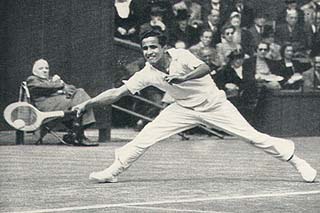
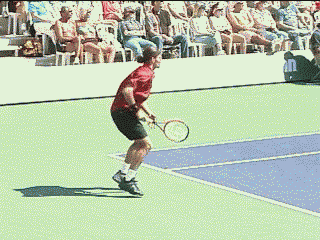
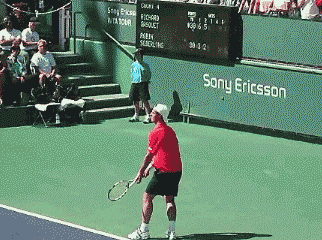
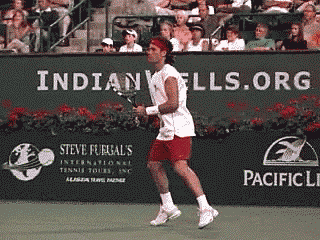
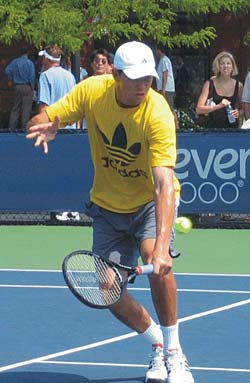 Photo 2. Bob Bryan adjusts his grip on the low forehand volley.
Photo 2. Bob Bryan adjusts his grip on the low forehand volley.